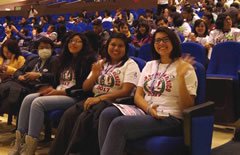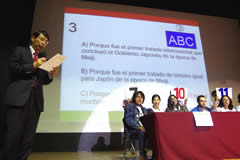Japanese-Language Education in Mexico, Central America, and the Caribbean
The Japan Foundation, Mexico
ARISUE Jun, ABE Yasuko, MATSUDA Ryoko
According to the Survey on Japanese-Language Education Abroad 2015, 9,240 people are studying at Japanese-language educational institutions in Mexico. That represents a rise of 35% over the 6,841 learners from the previous Survey in 2012, though the country remains in 23rd place in the world. This is the highest number for any country in the Spanish-speaking world. While the number of Mexicans working as Japanese interpreters due to the recent increasing presence of Japanese automakers in the country, the biggest reason that Mexicans wish to learn Japanese turns out to be pop culture. Most Japanese can only come up with tacos, cactus, and mariachi when they think of Mexico, many Mexicans are actually big Japanophiles who become familiar with Japanese culture through Anime and Manga.
The First Hosting of the Japan Bowl en México, a Japanese-Language Quiz Competition.
There have long been major events such as Japanese-language educational symposiums and Japanese speech contests held in Mexico, but a more recent addition has been made to this trend: the Japan Bowl en México. The memorable first event was held in February 2017, modeled after the National Japan Bowl, a Japanese-language quiz competition held in the US. The first event, managed by an organizing committee of volunteers with support from the Japan Foundation, Mexico, was able to acquire the support of numerous sponsors despite their lack of a track record, including embassies, the chamber of commerce, and airline companies.
A total of 45 teams participated in the event in the general public and high school divisions. The teams compete in quizzes on the Japanese language and culture. The division for the general public in particular does not require extensive knowledge of Japanese, which allows many beginner learners to participate, something that had be difficult with existing Japanese related events.
The preliminary qualifying round is carried out first in writing. Teams of three work together to solve a total of 60 questions displayed on a screen. Then, the top three high school teams and top six teams from the general public advance to the final tournament, which involves a quiz competition where points go to the first team to press the buzzer for each question. The final tournament involves finals for the three high school teams and two semifinals and a loser’s bracket for the general public division.

A scene before the opening of the Japan Bowl en México
The general public division also involves special questions posed by the Japanese ambassador to Mexico. The finals this time featured surprising upset after upset in both the high school and general public finals to the great excitement of all in attendance. As one of the organizers, hearing not only the team members but also the audience, sponsors, and other attendees say how much fun they had when it was over was ample reward for efforts that when into preparing for the event over such a long time.
Compared to the existing Japanese-language education related events in Mexico, the Japan Bowl en México quiz competition is set slightly apart by its high entertainment value. My hope is that it will take root and continue to develop as an important event for the spread of the Japanese language through the cooperation of Japanese learners, sponsor companies and organizations, and the organizing committee led primarily by Japanese teachers.
Videos of the competition and of competitors, as well as photos from the day of the event, can be viewed on the event’s website. You can check them out at the URL below.
https://www.facebook.com/japanbowlmexico
From Point to Line to Surface
The Japan Foundation, Mexico manages operations not only in Mexico but also Central America and the Caribbean region as well. The countries where we have confirmed that Japanese-language education is taking place in the Central America and Caribbean region are Honduras, Costa Rica, Guatemala, El Salvador, Cuba, Jamaica, Nicaragua, Panama, Trinidad and Tobago, and the Dominican Republic (from the Survey Report on Japanese-Language Education Abroad 2015, in order of the number of learners). The Japanese-Language Specialists in charge of the Central America and Caribbean region (hereinafter “Specialists”) have visited each of these countries for research, classroom observations, and seminars over the past three years. We were also invited to Brazil, the US, and Peru to participate in seminars and meetings.
While some Central American countries have a majority of native speaking Japanese teachers, others have almost none due to issues such as poor security. There are even times when students’ eyes light up when I speak to them during class because it’s the first time they spoke to a Japanese person. But even in those countries, it is now possible to easily communicate with Japanese people over the Internet. We will continue to work with local teachers to find the best approach to Japanese-language education in Central America and the Caribbean while adapting to the changing environment.

Japan Bowl en México
General Division Finals
Special questions submitted by the Ambassador of Japan to Mexico
The countries of the region have formed their own Central America and Caribbean Network for Japanese-Language Education, and country representatives gather once per year for a seminar run by the organization. The Specialists travel along with a representative of the Mexican Association of Japanese Language to assist in networking between teachers throughout the region. As a result, members of the network were able to attend a Japanese-language education symposium in Mexico and the Japan Bowl en México with assistance from the Japan Foundation. Exchange via the Internet has also been on the rise, such as participation from the Central America in the Latin America and Caribbean Presentation Video Contest hosted by a Mexican organization.
In addition to Central America and the Caribbean, I also traveled with a representative of the Mexican Association of Japanese Language to Peru for a liaison conference on Japanese-language education in Spanish-speaking South America, where we had a variety of discussions with representatives from the countries of the overall region. My hope is that the Spanish-speaking Central America and Caribbean countries network will connect with the network of Spanish-speaking countries of South America to share information about Japanese-language education and host events together.
One thing I enjoy about being a Specialist is to connect the points to form lines between the countries, in turn creating a surface, or place for greater activities, and to furthermore start up new Japanese-language education related activities and support the management thereof.
- What We Do Top
- Arts and Cultural Exchange [Culture]
- Japanese-Language Education Overseas [Language]
- Japanese-Language Education Overseas [Language] Top
- Learn Japanese-language
- Teach Japanese-language
- Take Japanese-Language Test
- Know about Japanese-language education abroad
- The Japanese-Language Institute, Urawa
- The Japanese-Language Institute, Kansai
- Japanese-Language Programs for Foreign Specified Skilled Worker Candidates
- Japanese Language Education for Japanese Children Resident Overseas and for the Descendants of Migrants
- Archives
- Japanese Studies and Global Partnerships [Dialogue]
- JF digital collection
- Other Programs / Programs to Commemorate Exchange Year
- Awards and Prizes
- Publications
